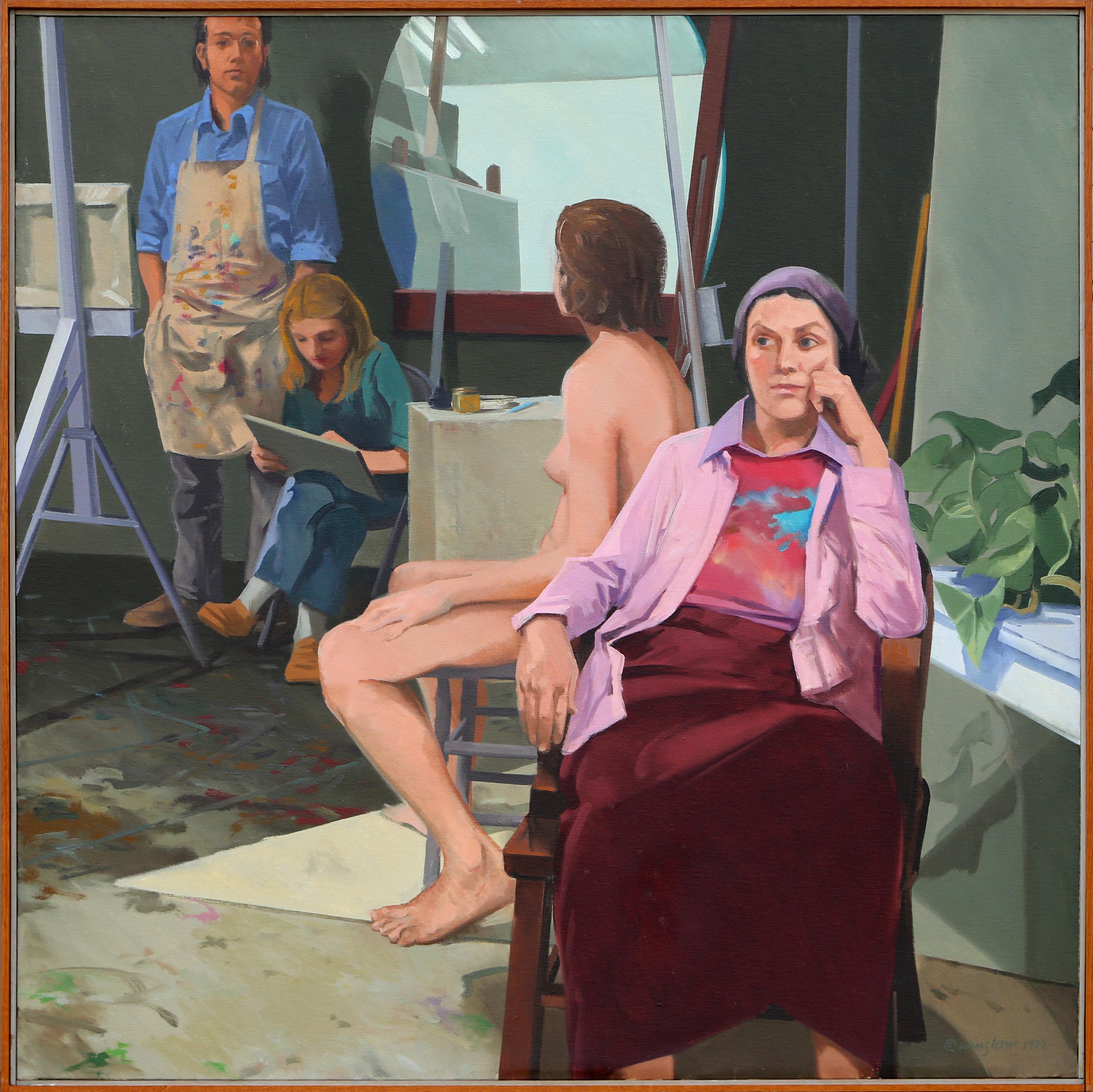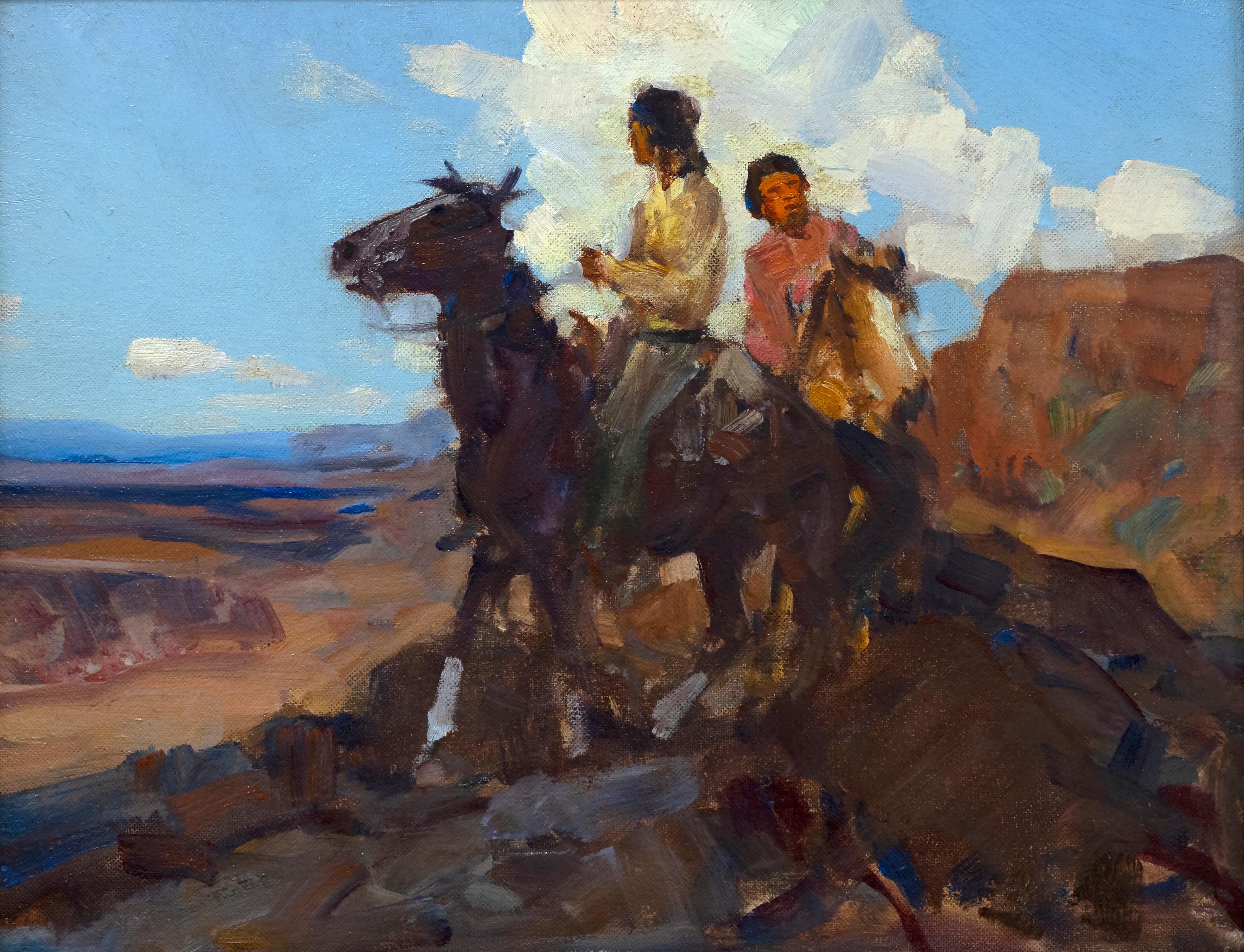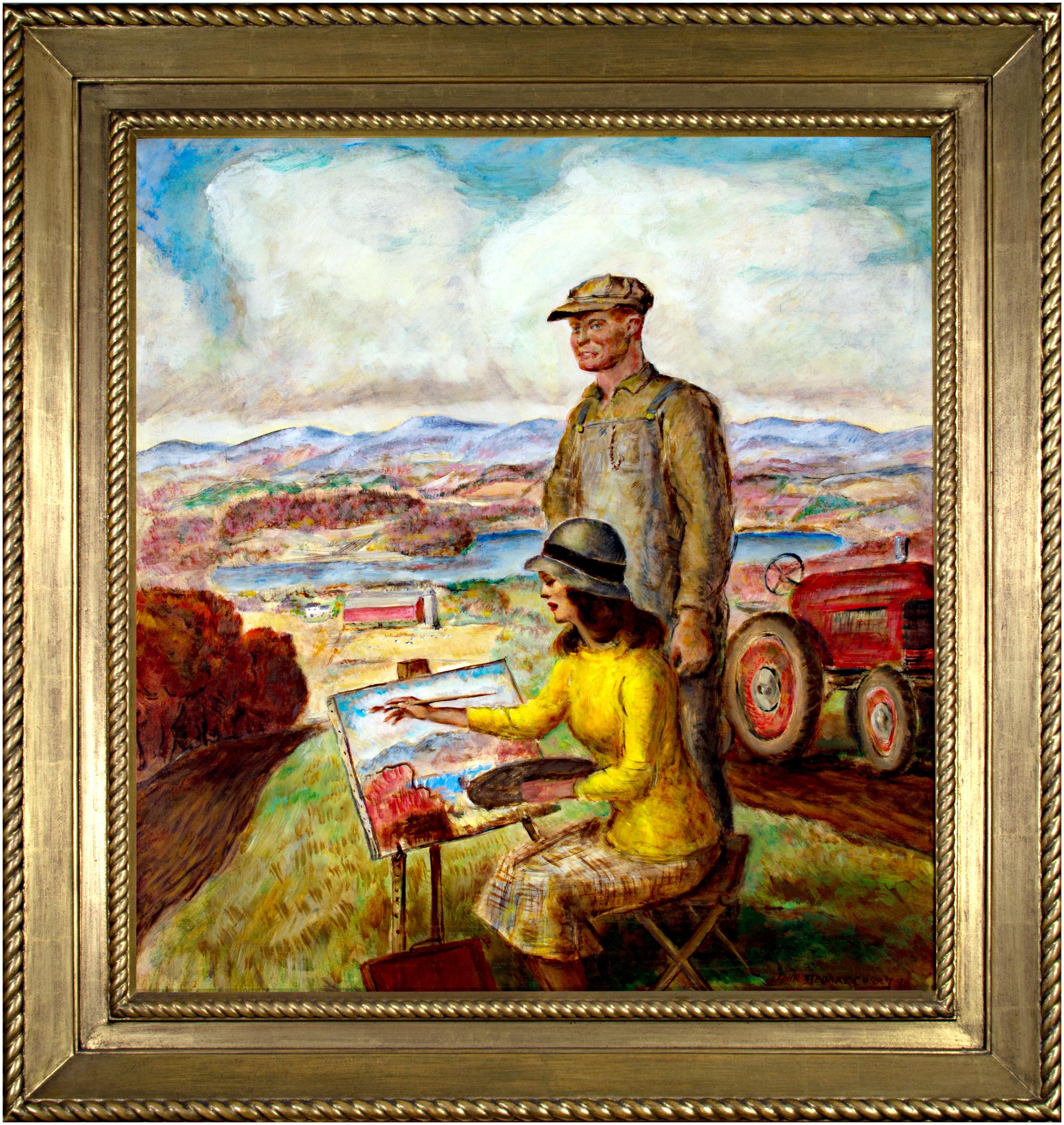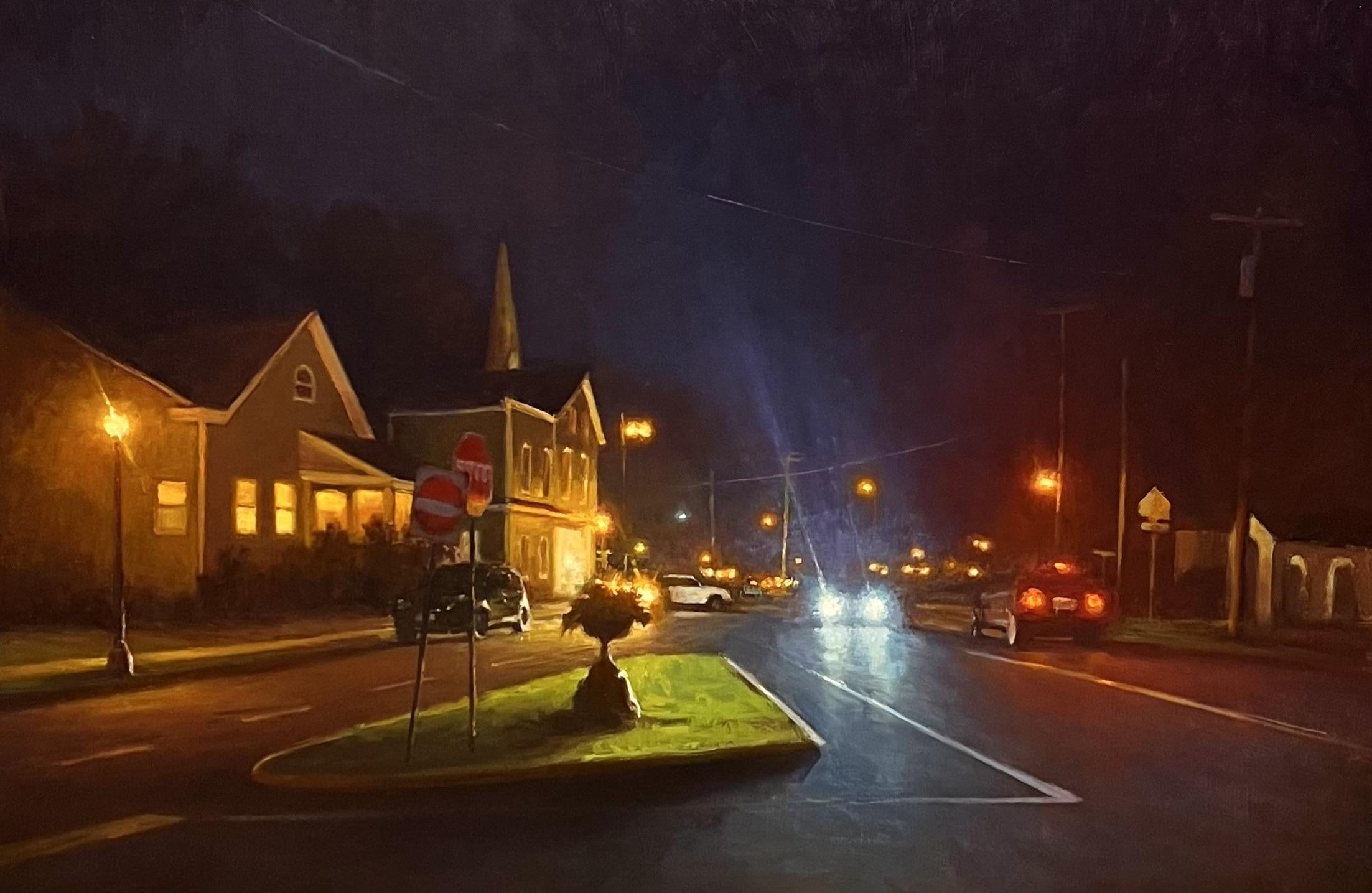Items Similar to Band Of Street Urchins (Charles Dickens) Large Oil Painting
Want more images or videos?
Request additional images or videos from the seller
1 of 6
Barry Leighton-JonesBand Of Street Urchins (Charles Dickens) Large Oil Painting
About the Item
Genre: Other
Subject: People
Medium: Oil
Surface: Canvas
Country: United Kingdom
Dimensions: 48" x 36" x 3/4"
Dimensions w/Frame: 48 3/4" x 37"
Barry Leighton-Jones was born in London, England in 1932 and is a direct descendant of the Victorian artist and President of the Royal Academy, Lord Frederic Leighton. He began his artistic career at the age of five by winning a major art competition, and later completed seven years of academic training at Sidcup and Brighton and was tutored by the acclaimed English artist and illustrator from the Royal College of Art - John Minton.
After launching himself straight into the British art world, his paintings were very quickly in demand - many of them were published and his international reputation grew. But the real breakthrough came in 1985, when he was selected by the Kelly Estate to create a series of images based on the life and work of the famous American clown - Emmett Kelly.
Taking a page out of Norman Rockwell's book, Leighton-Jones devoted a great amount of time to the preparation stage more than ever before. The Kelly Estate supplied Leighton-Jones with black and white photographs of Kelly throughout his career, and he took it upon himself to carefully study Kelly's work on film and read everything about the great man. He even completed visits to the Ringling Museum in Sarasota. All this preparation paid off, as the result is the comprehensive series of paintings, which join the different periods of Kelly's life. Many of the paintings and sketches were produced as limited edition prints and figurines, all becoming best sellers and eagerly sought after by collectors all over the U.S.A.
The years between 1986 and 1992 define one of the most important and prolific periods in the career of Barry Leighton-Jones. Those years mark his selection by various licensors to produce paintings with the purpose of reproduction in several forms: prints, collectors plates, figurines, etc. Although the foremost of these commissions were "The Emmett Kelly Collection", he also completed "The Gone With the Wind Collection" and "The Wizard of Oz Collection", as well as a number of portraits and collages of some of the 19tgh centuries' most famous faces, including Albert Einstein, John Lennon and Princess Diana.
Leighton-Jones, although best known for his clowns and urchins, has completed many different series of works, in many different styles. His work, whether of clowns, children, social situations, pub scenes, or "the weighty ladies", is recognizable from all others as a mixture of the classical and the modern. His realistic rendition of the human form, combined with an impressionistic background, creates a timeless and compelling image that speaks to children of all ages.
"Humor in art is a British tradition going back to Hogarth and Rowlandson, yet is rare today outside the world of political cartooning. For 50 years or so, I have used humor in many of my paintings and continue to do so. Much of the subject matter derives from childhood memories and early manhood experiences, i.e. the wedding breakfasts, the pubs and the weighty ladies. For the past 25 years I have lived and exhibited in the U.S.A. showing to a varied ethnic and cultural clientele. At first I wasn't sure how the British sense of humor would be appreciated but my doubts were dissolved when these people began to buy the works. Men and women identified different characters in my pictures as people they knew as friends or relatives. On numerous occasions I was asked to dedicate the pieces personally to the buyer as he or she found a resemblance to a character. Most artists are pleased when their works are beautifully painted, I'm happy when a painting elicits a good laugh". Barry Leighton-Jones
- Creator:Barry Leighton-Jones (1932, British)
- Dimensions:Height: 48.75 in (123.83 cm)Width: 37 in (93.98 cm)
- Medium:
- Movement & Style:
- Period:
- Condition:
- Gallery Location:Surfside, FL
- Reference Number:
About the Seller
4.9
Platinum Seller
These expertly vetted sellers are 1stDibs' most experienced sellers and are rated highest by our customers.
Established in 1995
1stDibs seller since 2014
1,560 sales on 1stDibs
Typical response time: 1 hour
- ShippingRetrieving quote...Ships From: Surfside, FL
- Return PolicyA return for this item may be initiated within 3 days of delivery.
More From This SellerView All
- 1930s Vintage Oil Painting Girl, Puppy Dog, American Illustrator Lawrence WilburBy Lawrence WilburLocated in Surfside, FLA girl and her dog This was possibly used as an advertisement. It is in a great illustrator style. 22 x 18. framed. 19.5 x 15.5 canvas. Lawrence Wilbur (1897 - 1960) was active/l...Category
1930s American Realist Figurative Paintings
MaterialsCanvas, Oil
- African American Realist Oil Painting Baseball Outsider Folk Art Andrew TurnerBy Andrew TurnerLocated in Surfside, FLTitle: Home Run Genre: Realism, sports, baseball Subject: People Medium: Oil (this might be acrylic, it feels like oil) on canvas Country: United States Dimensions: framed 23 X 25 sight 17.5 X 19.5 Provenance: Sande Webster Gallery in Philadelphia (bears label verso) Faintly signed lower right (see photos) Andrew Turner was born in 1944 in Chester, Pennsylvania. He was a graduate of Temple University Tyler School of Art. Andrew’s work has been widely acclaimed, with many solo exhibitions and participation in group exhibitions. He has taught art in grades K-12 in the Chester, Pennsylvania Public Schools and in correctional centers. His appointments include Artist-in-Residence and Curator, Deshong Museum, Chester, PA; Lecturer, Widener University; Lecturer, Institute of Contemporary Art, University of Pennsylvania, Philadelphia, PA; and, he toured and lectured in The People’s Republic of China. Andrew’s paintings are included in the collections of Woody Allen, Dr. Maya Angelou, ARCO Chemical Company, Bell Telephone Company, Dr. Constance Clayton, Mr. and Mrs. Bill Cosby, Edie Huggins, the artist previously known as Prince, Maya Angelou, Eric Lindros, Mr. and Mrs Louis Madonni, Moses Malone, Penn State University, Prince, Mr. and Mrs. Harold Sorgenti, Swarthmore College, Mrs. Marilyn Wheaton, and Widener University Deshong Museum, just to name a few. He has been featured in numerous solo exhibitions and group exhibitions in the United States and abroad. In an interview prior to his death in 2001, Turner noted, "My paintings combine the drama inherent in seventeenth century Dutch painting with the brush work and the economy of the Impressionists. However, I look to the jazz idiom more so than to other contemporary visual artists for guidance and inspiration. I tend to measure the success of my pieces by how they stand up technically, emotionally and innovatively to a John Coltrane solo or whether I've captured the spirit of the occasion, a la Duke Ellington. The subject matter, sometimes nostalgic recollections of my days as a young tough, covers a myriad of common folk activities. This one is reminiscent of Purvis Young. "The setting, usually my native Chester, is a beehive of creative stimulation or a deteriorating ghetto depending on my state of mind. At the very least, hopefully, these vignettes of experience will help to provide insight into some African American lifestyles and serve as an inspiration to my students and others to continue the legacy of African American participation in the arts." Folk Artist, Outsider artist, Folk Art. His work is from the true original street artist such as Purvis Young and the early Brooklyn street art Jean Michel Basquiat. “My paintings combine the drama inherent in seventeenth century Dutch painting with the brush work and the economy of the Impressionists. However, The setting usually my native Chester, is a beehive of creative stimulation or a deteriorating ghetto depending on my state of mind. At the very least, hopefully, these vignettes of experience will help to provide insight into some African American lifestyles and serve as an inspiration to my students and others to continue the legacy of African American participation in the arts.” He was included in the seminal show PHILADELPHIA (PA). Woodmere Art Museum. In Search of Missing Masters: The Lewis Tanner Moore Collection of African American Art. September 28, 2008-February 22, 2009. Artists: Henry Ossawa Tanner, Romare Bearden, Elizabeth Catlett, Barbara Chase-Riboud, Joseph Delaney, Sam Gilliam, Leroy Johnson, Lois Mailou Jones...Category
1970s American Realist Figurative Paintings
MaterialsOil, Canvas, Acrylic
- Street Riot Oil Painting Mounted Police WPA artist Social Justice Americana ArtBy Arthur SmithLocated in Surfside, FLRiot, Revolution, Police figures on Horseback in City Streets. Hand signed lower right. Painting measures 6 x 12, framed 9 x 15 inches. Arthur Smith is a...Category
Mid-20th Century American Realist Figurative Paintings
MaterialsOil, Panel
- Original Vintage Illustration Boy with Horse Oil Painting AmericanaBy Ariane BeigneuxLocated in Surfside, FLThis painting, exemplifies the type of traditional portraits the artist Ariane Beigneux was specially known for. Here, Beigneux depicts the portrait of a little boy and horse in a realistic, and seemingly idealized manner. The artist uses local colors and controlled brushstrokes to render the subject, paying close attention to details adding a special clarity to the naturalism of the portrait. it is painted on Whatman illustration board. some drawing in the margins. Ariane Beigneux was born to French parents in Roxbury, CT in 1918 and passed in 2011. She studied art at the National Academy of Design with Gifford Beal, Sidney Dickinson and Ivan Olinsky and at the Art Students League in New York with Jon Corbino and Jean Liberte. Ariane painted professional artist childrens portraits for six decades. Her work was included in the book 6 Artists Paint a Portrait: Alfred Chadbourn...Category
Mid-20th Century American Realist Figurative Paintings
MaterialsOil, Illustration Board
- Social Realist GREEN STAIRS Architectural Street Scene Landscape Oil PaintingBy Paul ZimmermanLocated in Surfside, FLOil on artist's board, late 20th century, signed P. Zimmerman Reminiscent of the Mid Century Social Realist and WPA works of Ben Shahn this captures an architectural street scape...Category
Mid-20th Century American Realist Landscape Paintings
MaterialsOil, Board
- Social Realist Street Scene of Youth at Play (African American)By Paul ZimmermanLocated in Surfside, FLOil on artist's board, late 20th century, signed "P. Zimmerman" lower right; [Sight: 8 1/2" x 20 1/2"; Frame: 12 1/2" x 25"]. Reminiscent of the Mid Century Social Realist and WPA wo...Category
Mid-20th Century American Realist Figurative Paintings
MaterialsOil, Board
You May Also Like
- VictoryLocated in Ibadan, Oyo"Victory" emanates a sense of vibrancy and vitality, drawing viewers into its world of anticipation and celebration. The central figure, depicted with a wide grin and laughter lines ...Category
21st Century and Contemporary American Realist Mixed Media
MaterialsCanvas, Mixed Media, Oil, Acrylic
- In the Studio, Large Painting by John WinslowLocated in Long Island City, NYA large (48 x 48 inch) painting of a scene in the art studio by American artist John Winslow (1938 - ).Category
1970s American Realist Figurative Paintings
MaterialsCanvas, Oil
- ScoutingBy Frank Tenney JohnsonLocated in Palm Desert, CA"Scouting" is an oil on canvas painting by Frank Tenney Johnson. The framed piece measures 23 3/4 x 27 3/4 x 3 1/4 inches. Johnson was well-known for his work of the American west, particularly for his portrayal of cowboys at night, lit by moonlight. Johnson utilized knives and fingers when painting, so his work is recognizable for its distinctive marks. Provenance: Biltmore Galleries, Scottsdale...Category
Early 20th Century American Realist Landscape Paintings
MaterialsCanvas, Oil
- 'Sketching Wisconsin' original oil painting, SignedBy John Steuart CurryLocated in Milwaukee, WIJohn Steuart Curry "Sketching Wisconsin," 1946 oil on canvas 31.13 x 28 inches, canvas 39.75 x 36.75 x 2.5 inches, frame Signed and dated lower right Overall excellent condition Presented in a 24-karat gold leaf hand-carved wood frame John Steuart Curry (1897-1946) was an American regionalist painter active during the Great Depression and into World War II. He was born in Kansas on his family’s farm but went on to study art in Chicago, Paris and New York as young man. In Paris, he was exposed to the work of masters such as Peter Paul Rubens, Eugène Delacroix and Jacques-Louis David. As he matured, his work showed the influence of these masters, especially in his compositional decisions. Like the two other Midwestern regionalist artists that are most often grouped with him, Grant Wood (American, 1891-1942) and Thomas Hart Benton (American, 1889-1975), Curry was interested in representational works containing distinctly American subject matter. This was contrary to the popular art at the time, which was moving closer and closer to abstraction and individual expression. Sketching Wisconsin is an oil painting completed in 1946, the last year of John Steuart Curry’s life, during which time he was the artist-in-residence at the University of Wisconsin in Madison. The painting is significant in Curry’s body of work both as a very revealing self-portrait, and as a landscape that clearly and sensitively depicts the scenery of southern Wisconsin near Madison. It is also a portrait of the artist’s second wife, Kathleen Gould Curry, and is unique in that it contains a ‘picture within a picture,’ a compositional element that many early painting masters used to draw the eye of the viewer. This particular artwork adds a new twist to this theme: Curry’s wife is creating essentially the same painting the viewer is looking at when viewing Sketching Wisconsin. The triangular composition of the figures in the foreground immediately brings focus to a younger Curry, whose head penetrates the horizon line and whose gaze looks out towards the viewer. The eye then moves down to Mrs. Curry, who, seated on a folding stool and with her hand raised to paint the canvas on the easel before her, anchors the triangular composition. The shape is repeated in the legs of the stool and the easel. Behind the two figures, stripes of furrowed fields fall away gently down the hillside to a farmstead and small lake below. Beyond the lake, patches of field and forest rise and fall into the distance, and eventually give way to blue hills. Here, Curry has subverted the traditional artist’s self-portrait by portraying himself as a farmer first and an artist second. He rejects what he sees as an elitist art world of the East Coast and Europe. In this self-portrait he depicts himself without any pretense or the instruments of his profession and with a red tractor standing in the field behind him as if he was taking a break from the field work. Here, Curry’s wife symbolizes John Steuart Curry’s identity as an artist. Compared with a self-portrait of the artist completed a decade earlier, this work shows a marked departure from how the artist previously presented and viewed himself. In the earlier portrait, Curry depicted himself in the studio with brushes in hand, and with some of his more recognizable and successful canvases behind him. But in Sketching Wisconsin, Curry has taken himself out of the studio and into the field, indicating a shift in the artist’s self-conception. Sketching Wisconsin’s rural subject also expresses Curry’s populist ideals, that art could be relevant to anyone. This followed the broad educational objectives of UW’s artist-in-residence program. Curry was appointed to his position at the University of Wisconsin in 1937 and was the first person to hold any such position in the country, the purpose of which was to serve as an educational resource to the people of the state. He embraced his role at the University with zeal and not only opened the doors of his campus studio in the School of Agriculture to the community, but also spent a great deal of time traveling around the state of Wisconsin to visit rural artists who could benefit from his expertise. It was during his ten years in the program that Curry was able to put into practice his belief that art should be meaningful to the rural populace. However, during this time he also struggled with public criticism, as the dominant forces of the art market were moving away from representation. Perhaps it was Curry’s desire for public acceptance during the latter part of his career that caused him to portray himself as an Everyman in Sketching Wisconsin. Beyond its importance as a portrait of the artist, Sketching Wisconsin is also a detailed and sensitive landscape that shows us Curry’s deep personal connection to his environment. The landscape here can be compared to Wisconsin Landscape of 1938-39 (the Metropolitan Museum of Art), which presents a similar tableau of rolling hills with a patchwork of fields. Like Wisconsin Landscape, this is an incredibly detailed and expressive depiction of a place close to the artist’s heart. This expressive landscape is certainly the result of many hours spent sketching people, animals, weather conditions and topography of Wisconsin as Curry traveled around the state. The backdrop of undulating hills and the sweeping horizon, and the emotions evoked by it, are emphatically recognizable as the ‘driftless’ area of south-central Wisconsin. But while the Metropolitan’s Wisconsin Landscape conveys a sense of uncertainty or foreboding with its dramatic spring cloudscape and alternating bands of light and dark, Sketching Wisconsin has a warm and reflective mood. The colors of the foliage indicate that it is late summer and Curry seems to look out at the viewer approvingly, as if satisfied with the fertile ground surrounding him. The landscape in Sketching Wisconsin is also revealing of what became one of Curry’s passions while artist-in-residence at UW’s School of Agriculture – soil conservation. When Curry was a child in Kansas, he saw his father almost lose his farm and its soil to the erosion of The Dust Bowl. Therefore, he was very enthusiastic about ideas from UW’s School of Agriculture on soil conservation methods being used on Wisconsin farms. In Sketching Wisconsin, we see evidence of crop rotation methods in the terraced stripes of fields leading down the hillside away from the Curry’s and in how they alternate between cultivated and fallow fields. Overall, Sketching Wisconsin has a warm, reflective, and comfortably pastoral atmosphere, and the perceived shift in Curry’s self-image that is evident in the portrait is a positive one. After his rise to favor in the art world in the 1930’s, and then rejection from it due to the strong beliefs presented in his art, Curry is satisfied and proud to be farmer in this self-portrait. Curry suffered from high blood...Category
1940s American Realist Figurative Paintings
MaterialsCanvas, Oil
- Self Wearing Bag (leather, satchel, brown, oil painting, vintage, monochrome)By Rudolf KosowLocated in Quebec, QuebecSuperbe original painting on canvas depicting an Anonymous man holding a Brown leather satchel. keywords; Brown leather, satchel, travel bag, americana, surrealism, vintage, oil pai...Category
2010s American Realist Figurative Paintings
MaterialsCanvas, Oil
- Division Street at Night - 2023, American realist nocturne by Carl BretzkeBy Carl BretzkeLocated in Sag Harbor, NYAmerican realist painter Carl Bretzke is particularly adept at nocturne scenes which ooze in darkness, reminiscent of Edward Hopper. Bretzke remarks: “What most people don’t notice i...Category
2010s American Realist Landscape Paintings
MaterialsCanvas, Linen, Oil
Recently Viewed
View AllMore Ways To Browse
Oil Paintings Of Charles
Oil Painting Charles
Oil Painting By Charles
Charles Wells Painting
Royal Street
Presidents Oil Paintings
Charles Street
Charles I Painting
Page Oil Painting
Large Realist Oil Paintings
Wedding Painting
M Charles
London Streets Oil
Mark English Painting
3 Children Painting
Charles White Artist
Very Large Figurative Oil Paintings
Cartoon Character Paintings




